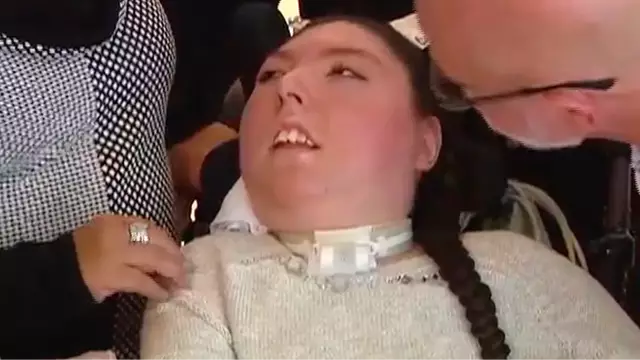Alex Simpson’s 20-year story of survival without the vast majority of her brain defies all medical expectations
A woman born without most of her brain has shattered medical expectations recently, celebrating her 20th birthday with her family despite being told she would not make it past the age of four.
Alex Simpson, from Nebraska, was diagnosed with an extremely rare birth defect when she was just two months old, when doctors discovered that she had been born without the vast majority of her brain, a condition known as Hydranencephaly.
While this condition can sometimes mean a child develops without ‘certain portions of their brain called the cerebral hemispheres’, per the Cleveland Clinic, in Alex’s case, Hydranencephaly left her with barely a pinky finger’s worth of brain in the cerebellum at the back of her skull.
Despite this, Alex this month celebrated her 20th birthday, with her parents crediting ‘love’ and ‘faith’ for the milestone.
Tragically, the lifespan of many children diagnosed with this condition is extremely short, often measured in months or a few short years. Many are diagnosed with this life-limiting disorder shortly after birth, with clear and worrying symptoms that point to an issue with brain development.

What is Hydranencephaly?
Hydranencephaly is a condition that typically develops at around the 12th week of pregnancy, a key moment in the brain’s formation. It stems from damage caused to the fetal nervous system during development.
This can cause large portions of the brain to not grow and instead, large sacs filled with cerebrospinal fluid (CSF) tend to form in these cavities. In the usual development of a brain, CSF is a vital component of cushioning your brain within the skull and maintaining its health.
However, in babies with Hydranencephaly, these fluid sacs will continue to fill with CSF, causing one of the key features of the condition, an enlarged skull.
Most cases of the condition are diagnosed months after birth, as some children will be born without any immediate signs of the defect, with some symptoms only manifesting in babies of between two and four months.
Sometimes, Hydranencephaly can be picked up during pregnancy by fetal ultrasounds, often leading to medical abortion due to the drastically shortened life expectation of the child.

How to spot Hydranencephaly symptoms
Babies born with this condition tend to present with three main symptoms that will trigger an immediate medical investigation.
While an enlarged or misformed head is the most telltale sign of Hydranencephaly, doctors will also look for unusual irritability and hypertonia, an increase in a baby’s muscle tone usually associated with stiffness.
After just a few months with this disorder, a baby can also experience blindness, seizures, and paralysis.
Medical professionals typically diagnose Hydranencephaly after carrying out an ultrasound of a baby’s head, according to childhood disability charity Contact.
In severe cases for babies born without the vast majority of their brains, EEG tests for brain activity will discover that there is no brain activity at all due to the large cavities formed before birth.
What causes Hydranencephaly?
The precise causes of Hydranencephaly are unknown. However, health experts have been able to identify several circumstances that can cause the onset of the condition.
Often, there will be no one event during pregnancy to attribute a cause to, despite the severity of the disorder.
Recognised causes of Hydranencephaly have included the death of a twin during the second trimester, as well as several acute circumstances, such as the baby experiencing blood loss during the early stages of development.
Genetics and inherited conditions are not thought to cause the condition to develop, with most medical literature pointing to vascular issues after the first trimester as the predominant reason that a baby might develop without most of their brain.
In a small number of cases, this condition can even form after birth as a result of severe injury from illnesses like meningitis or stroke.

How rare is Hydranencephaly and how is it treated?
Hydranencephaly is an exceedingly rare birth defect, affecting either one in 5000 or one in 10,000 births, with varying levels of severity.
Those babies with the most severe forms of the condition will often die at birth. Others born with Hydranencephaly and an enlarging head will usually have a shunt installed in their brain to prevent any further expansion.
There is no cure for this birth defect, and beyond treatment to prevent more CSF from flooding into the brain cavity, there is little that can be done for sufferers apart from anti-seizure medication and continuous intensive care.
Most babies do not live beyond a year when afflicted with Hydranencephaly, making Alex Simpson’s celebration of her 20th birthday all the more remarkable.


